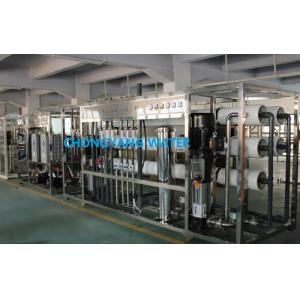
Add to Cart
Product Name:Large Capacity Food And Beverage Water Treatment RO Mineral Water Purification Plant
What process is the drink water treatment ?
The process of water treatment for drinking water typically involves several steps to remove impurities and contaminants. The exact process can vary depending on the source of the water and the specific treatment plant, but the following steps are commonly used:
Coagulation and Flocculation: In this step, chemicals are added to the water to create clumps of dirt, bacteria, and other impurities, which are called flocs. The flocs are then removed more easily in later steps.
Sedimentation: The water is allowed to sit still in a large tank so that the heavier flocs settle to the bottom, forming a layer of sediment.
Filtration: The water is passed through various filters, such as sand, gravel, and activated carbon, to remove smaller impurities that were not removed in the previous steps.
Disinfection: To kill any remaining bacteria, viruses, and other microorganisms, the water is disinfected with chemicals such as chlorine or ozone.
PH Adjustment: The pH of the water may be adjusted to make it less corrosive and to prevent lead and other metals from leaching into the water from pipes.
Fluoridation: Some water treatment plants add fluoride to the water to help prevent tooth decay.
Storage and Distribution: The treated water is stored in a reservoir and then distributed to homes and businesses through a network of pipes.
Overall, the goal of the water treatment process is to provide safe and clean drinking water that meets regulatory standards for quality and safety.
The Partial Product Specification:
| Type | Capacity (M3/H) | Pipe DN (mm) | WP (MPa) | Material | Work Method |
| CY-RO-0.25 | 0.25 | DN20 | ≤1.0 | Stainless Steel/Carbon Steel | Full Auto/Semi Automatic |
| CY-RO-0.5 | 0.5 | DN20 | ≤1.0 | Stainless Steel/Carbon Steel | Full Auto/Semi Automatic |
| CY-RO-1 | 1 | DN25 | ≤1.0 | Stainless Steel/Carbon Steel | Full Auto/Semi Automatic |
| CY-RO-2 | 2 | DN32 | ≤1.0 | Stainless Steel/Carbon Steel | Full Auto/Semi Automatic |
| CY-RO-3 | 3 | DN40 | ≤1.0 | Stainless Steel/Carbon Steel | Full Auto/Semi Automatic |
| CY-RO-5 | 5 | DN50 | ≤1.0 | Stainless Steel/Carbon Steel | Full Auto/Semi Automatic |
| CY-RO-10 | 10 | DN75 | ≤1.0 | Stainless Steel/Carbon Steel | Full Auto/Semi Automatic |
| CY-RO-20 | 20 | DN100 | ≤1.6 | Stainless Steel/Carbon Steel | Full Auto/Semi Automatic |
| CY-RO-30 | 30 | DN125 | ≤1.6 | Stainless Steel/Carbon Steel | Full Auto/Semi Automatic |
| CY-RO-40 | 40 | DN150 | ≤1.6 | Stainless Steel/Carbon Steel | Full Auto/Semi Automatic |
| CY-RO-50 | 50 | DN200 | ≤1.6 | Stainless Steel/Carbon Steel | Full Auto/Semi Automatic |


FAQ:
1.Question:How often should I replace the filters in a reverse osmosis system?
Answer:As a general guideline, it's recommended that the pre-filter and post-filter be replaced every 3-6 months.
2.Question:How to maintain the big capacity Reverse Osmosis System ?
Answer: 1.Regularly check the system for leaks 2.Monitor water pressure 3.Inspect and clean the pre-filters.
3.Question: How to install RO Plant?
Answer:Install the RO system equipment, including pre-filters, pumps, membranes, and post-filters, according to the manufacturer's instructions and any applicable regulations,we can provide video by wechat ,whatsapp number on-line .
4.Question: Where is the CHONGYANG Water located ?
Answer: SHANGHAI ,JIANGSU